Seepage Model of Heterogeneous Municipal Solid Waste Landfill and Application under Process of Waste Accumulation
Abstract
:1. Introduction
2. Seepage Mechanism of Municipal Solid Waste Landfill
2.1. Seepage Theory
2.2. Heterogeneous Seepage Theory
3. Materials and Models
3.1. Profile of Xi’an Jiangcungou Landfill
3.2. Parameters and Scheme Design of Waste Unit
3.3. Parameters and Scheme Design of the Xi’an Jiangcungou Landfill
3.4. Model
4. Results
4.1. Seepage Results of Waste Unit
4.2. Seepage Results from the Xi’an Jiangcungou Landfill
5. Discussion
6. Conclusions
- (1)
- Combined with the actual project of the Xi’an Jiangcungou Landfill, the heterogeneous seepage model was established to research the formation and transportation of the perched water level in landfill. When considering the landfill process and heterogeneous permeability, the maximum perched water levels of each layer were higher than the levels of homogeneous waste, and the differential values were about 0.08–1.88 m, which were not good for the stability of landfill.
- (2)
- The arrangement of the drainage layer significantly reduces the perched water level in the MSW layer. The maximum perched water level of the MSW layer was approximately 4.90–5.84 m in the landfill. During the initial stage of precipitation, this study observed a maximum difference of about 2.80 m in the perched water level of the MSW layer under two different drainage layer clogging conditions. However, the drainage layer has little impact on the perched water level in other MSW layers due to the interception of leachate by the covering layer. Therefore, it is recommended to install drainage pipes or implement shaft measures in all MSW layers of the landfill to reduce the perched water level.
- (3)
- Through finite element analysis, it was determined that the leachate water levels in the Xi’an Jiangcungou Landfill were high, with several layers of perched water levels. This can be attributed to the absence of drainage pipes initially buried in the initial landfill. Confined water heads were observed in the first layer of the MSW, while a higher unsaturated zone was present below the fourth layer of the MSW due to the presence of the drainage layer. The perched water level at the landfill surface layer was found to be approximately 6.24–7.13 m, which closely aligns with the actual survey data and references, thus validating the reliability of the proposed model in this study. These research findings not only offer technical support but also provide a theoretical foundation for the control of leachate levels and the safe operation of the landfill.
Author Contributions
Funding
Data Availability Statement
Acknowledgments
Conflicts of Interest
References
- Gao, W. Research on Time-Dependent Constitutive Models for Municipal Solid Waste and Service Performance of Landfills. Ph.D. Thesis, Zhejiang University, Hangzhou, China, 2018. [Google Scholar]
- Li, Z.J.; Huang, Y.L.; Ma, J.L.; Chen, M.S. Hidden trouble investigation and safety operation measures of waste landfill: Taking a waste landfill safety case as example. Environ. Sanit. Eng. 2017, 25, 91–96. [Google Scholar]
- Huang, Y.; Fan, G. Engineering geological analysis of municipal solid waste landfill stability. Nat. Hazards 2016, 84, 93–107. [Google Scholar] [CrossRef]
- Qian, X.D.; Koerner, R.M. Stability analysis when using an engineered berm to increase landfill space. J. Geotech. Geoenviron. Eng. 2009, 135, 1082–1091. [Google Scholar] [CrossRef]
- Qian, X.D. Limit equilibrium analysis of translational failure of landfills under different leachate buildup conditions. Water Sci. Eng. 2008, 1, 44–62. [Google Scholar]
- Liu, S.; Fan, S.G.; Sun, Z.H.; Zhang, X.X. Analysis of metal ion content in different treatment stages of landfill leachate. Appl. Chem. Ind. 2018, 47, 1304–1307. [Google Scholar]
- Wang, Y.Y. Study on the Impact of Leachate from Jiangcungou Landfill on the Surrounding Ecological Environment in Xi’an City. Master’s Thesis, Changan University, Xi’an, China, 2008. [Google Scholar]
- Zhang, C.; Liang, B.; Liu, L.; Wan, Y.; Zhu, Q.C. Determination of unsaturated hydraulic properties of seepage flow process in municipal solid waste. Water 2021, 13, 1059. [Google Scholar] [CrossRef]
- Yang, R.; Xu, Z.G.; Chai, J.R. A review of characteristics of landfilled municipal solid waste in several countries: Physical composition, unit weight and permeability coefficient. Pol. J. Environ. Stud. 2018, 27, 2425–2435. [Google Scholar] [CrossRef]
- Dixon, N.; Jones, D.R.V. Engineering properties of municipal solid waste. Geotext. Geomembr. 2005, 23, 205–233. [Google Scholar] [CrossRef]
- Hong, Y.; Xia, J.Q.; Thompson, J.R.; Flower, R.J. Urban construction and demolition waste and landfill failure in Shenzhen, China. Waste Manag. 2017, 63, 393–396. [Google Scholar]
- Yang, J.K. Research on Unsaturated Flow and Preferential Flow in Municipal Solid Waste. Master’s Thesis, Shanghai University, Shanghai, China, 2020. [Google Scholar]
- Zeiss, C.; Uguccioni, M. Mechanisms and patterns of leachate flow in municipal solid waste landfills. J. Environ. Syst. 1994, 23, 247–270. [Google Scholar] [CrossRef]
- He, H.J. Study on Leachate and Landfill Gas Generation, Transportation and Induced Slope Instability in Municipal Solid Waste Landfill. Ph.D. Thesis, Zhejiang University, Hangzhou, China, 2018. [Google Scholar]
- Zhang, W.J.; Lin, W.A.; Chen, Y.M. Pore pressure monitoring and slope stability analysis of a waste landfill. Chin. J. Rock Mech. Eng. 2010, 29, 3629–3632. [Google Scholar]
- Xu, X.B.; Zhan, L.T.; Chen, Y.M.; Beaven, R.P. Intrinsic and relative permeabilities of shredded municipal solid wastes from the Qizishan landfill, China. Can. Geotech. J. 2014, 51, 1243–1252. [Google Scholar] [CrossRef]
- Vrancken, C.; Longhurst, P.J.; Wagland, S.T. Critical review of real-time methods for solid waste characterisation: Informing material recovery and fuel production. Waste Manag. 2017, 61, 40–57. [Google Scholar] [CrossRef] [PubMed]
- Han, B.; Imhoff, P.T.; Yazdani, R. Field application of partitioning gas tracer test for measuring water in a bioreactor landfill. Environ. Sci. Technol. 2007, 41, 277–283. [Google Scholar] [CrossRef] [PubMed]
- Capelo, J.; de Castro, M. Measuring transient water flow in unsaturated municipal solid waste—A new experimental approach. Waste Manag. 2007, 27, 811–819. [Google Scholar] [CrossRef] [PubMed]
- Kim, Y.C.; Cramer, J.A.; Booksh, K.S. Investigation of a fiber optic surface plasmon spectroscopy in conjunction with conductivity as an in situ method for simultaneously monitoring changes in dissolved organic carbon and salinity in coastal waters. Analyst 2011, 136, 4350–4356. [Google Scholar] [CrossRef]
- Grellier, S.; Reddy, K.; Gangathulasi, J.; Peters, C. Electrical resistivity tomography imaging of leachate recirculation in orchards hills landfill. In Proceedings of the SWANA (Solid Waste Association of North America)’s 44th Annual International Solid Waste Exposition (WASTECON 2006), Charlotte, NC, USA, 19–21 September 2006. [Google Scholar]
- Zhang, W.J.; Zhan, L.T.; Chen, Y.M.; Wei, H.Y. Unsaturated-saturated seepage analysis of municipal solid wastes. Chin. J. Rock Mech. Eng. 2007, 26, 87–93. [Google Scholar] [CrossRef]
- Zhang, W.J. Experimental and Numberical Study on Water/Leachate Transport in Landfill of Municipal Solid Waste. Ph.D. Thesis, Zhejiang University, Hangzhou, China, 2007. [Google Scholar]
- Zhang, Z.; Wu, D.Z.; Zhang, L.F.; Yan, L. Study on the permeability and the permeable mechanism of the municipal solid waste. Energy Educ. Res. 2014, 32, 1517–1524. [Google Scholar]
- Chen, Y.M.; Ke, H. Engineering characteristics of municipal solid wastes and geotechnical problems of landfills. Eng. Mech. 2005, 22, 119–126. [Google Scholar]
- Yang, R.; Xu, Z.G.; Chai, J.R.; Qin, Y. Permeability test and slope stability analysis of municipal solid waste (MSW) in Jiangcungou Landfill, Shaanxi, China. J. Air Waste Manag. 2016, 66, 655–662. [Google Scholar] [CrossRef]
- Feng, S.J.; Gao, K.W.; Chen, Y.X.; Li, Y.; Zhang, L.M. Geotechnical properties of municipal solid waste at Laogang Landfill, China. Waste Manag. 2017, 63, 354–365. [Google Scholar] [CrossRef] [PubMed]
- Li, M.Y.; Jae, H.K.; Xu, Q.Y. Review about hydraulic conductivity of landfilled waste. Environ. Eng. 2014, 32, 80–88. [Google Scholar]
- Wang, W.F. Laboratory Research on Saturated Hydraulic Conductivity of Municipal Solid Waste under Different Degradation Age. Master’s Thesis, Zhejiang University, Hangzhou, China, 2013. [Google Scholar]
- Liu, Z. Experimental Study on Hydraulic Conductivity of Municipal Solid Waste and Analysis of Pumping Vertical Well. Master’s Thesis, Zhejiang University, Hangzhou, China, 2010. [Google Scholar]
- Ke, H.; Wang, W.F.; Wei, C.C.; Chen, Y.M.; Zhan, L.T. Experimental study on saturated hydraulic conductivity of MSW under different conditions. J. Zhejiang Univ. (Eng. Sci.) 2013, 47, 1164–1171. [Google Scholar]
- Qiu, Z.H.; He, C.M.; Zhu, B.J.; Chen, H.L. Investigations of water transport in valley–type MSW landfills and their stabilities subjected to various rainfall patterns. Rock Soil Mech. 2012, 33, 3151–3170. [Google Scholar]
- Wang, H.T.; Yin, Y. Numerical simulation of moisture movement in landfill bioreactors under the condition of leachate recirculation. Environ. Sci. 2003, 24, 66–72. [Google Scholar]
- Zhang, W.J. Analyses on a high leachate mound in a landfill of municipal solid waste in China. Environ. Earth Sci. 2013, 70, 1747–1752. [Google Scholar] [CrossRef]
- Jang, Y.S.; Kim, Y.W.; Lee, S.I. Hydraulic properties and leachate level analysis of Kimpo metropolitan landfill, Korea. Waste Manag. 2002, 22, 261–267. [Google Scholar] [CrossRef]
- Xu, Q.; Powell, J.; Tolaymat, T.; Tolaymat, T.G. Seepage control strategies at bioreactor landfills. J. Hazard. Toxic Radioact. Waste 2013, 17, 342–350. [Google Scholar] [CrossRef]
- Dai, Z.L.; Huang, Y.; Jiang, F.H.; Huang, M.S. Modeling the flow behavior of a simulated municipal solid waste. Bull. Eng. Geol. Environ. 2016, 75, 275–291. [Google Scholar] [CrossRef]
- Childs, E.C.; Collins-George, N. The permeability of porous materials. Proc. R. Soc. A 1950, 1066, 392–405. [Google Scholar]
- Richards, L.A. Capillary conduction of liquids through porous mediums. Physics 1931, 1, 318–333. [Google Scholar] [CrossRef]
- Mao, C.X. Seepage Computation Analysis and Control; China Water Power Press: Beijing, China, 1990; pp. 5–20. [Google Scholar]
- Gray, W.G.; Miller, C.T. On the algebraic and differential forms of Darcy’s equation. J. Porous Media 2011, 14, 33–50. [Google Scholar] [CrossRef]
- Peng, H.; Chen, S.H. Finite element analyses of unstable seepage in saturated-unsaturated rock. J. Hydrodyn. 2002, 17, 253–259. [Google Scholar]
- Li, X.; Gao, J.; Wang, Z.L.; Li, L. Three-dimensional calculation of seepage flow in saturated-unsaturated soil. Shuili Xuebao 1992, 11, 63–80. [Google Scholar]
- Fei, K.; Zhang, J.W. Application of ABAQUS in Geotechnical Engineering; China Water Power Press: Beijing, China, 2009; pp. 184–216. [Google Scholar]
- Shen, L. Liquid Depth Study and Stability Analysis of Municipal Solid Waste Landfill. Master’s Thesis, Zhejiang University, Hangzhou, China, 2011. [Google Scholar]
- MHURDPRC (Ministry of Housing and Urban-Rural Development of the People’s Republic of China). Technical Code for Geotechnical Engineering of Municipal Solid Waste Sanitary Landfill; CJJ176-2012; Construction Industry Press: Beijing, China, 2012. [Google Scholar]
- Jie, Y.X.; Danzeng, D.Z.; Wei, Y.F. Study on the permeability of municipal solid waste. Geotech. Eng. Tech. 2005, 19, 307–310. [Google Scholar]
- Dang, M.R.; Chai, J.R.; Xu, Z.G.; Qin, Y.; Cao, J.; Liu, Y.F. Soil water characteristic curve test and saturated–unsaturated seepage analysis in Jiangcungou municipal solid waste landfill, China. Eng. Geol. 2020, 264, 105374. [Google Scholar] [CrossRef]
- Lai, J.B.; Wang, Q.J. Comparison of soil water retention curve model. J. Soil Water Conserv. 2003, 17, 71–74. [Google Scholar]
- NBSPRC (National Bureau of Statistics of the People’s Republic of China). China Statistical Yearbook 2016; Statistics Press: Beijing, China, 2016. [Google Scholar]
- Shi, W.; Chai, X.L. Experiments on loess as intermediate cover in landfills in northwest China. J. Shanghai Univ. (Nat. Sci.) 2016, 22, 505–514. [Google Scholar]
- Zhang, W.J.; Chen, Y.M.; Zhan, L.T. Seepage and stability analysis of landfills. In Proceedings of the 2nd National Conference on Geotechnical and Engineering, Wuhan, China, 29–31 October 2006. [Google Scholar]
- Chen, Y.M.; Lan, J.W.; Li, Y.C.; Zhan, L.T.; Ke, H. Development and control of leachate mound in MSW landfills. Chin. J. Rock Mech. Eng. 2014, 33, 154–163. [Google Scholar] [CrossRef]

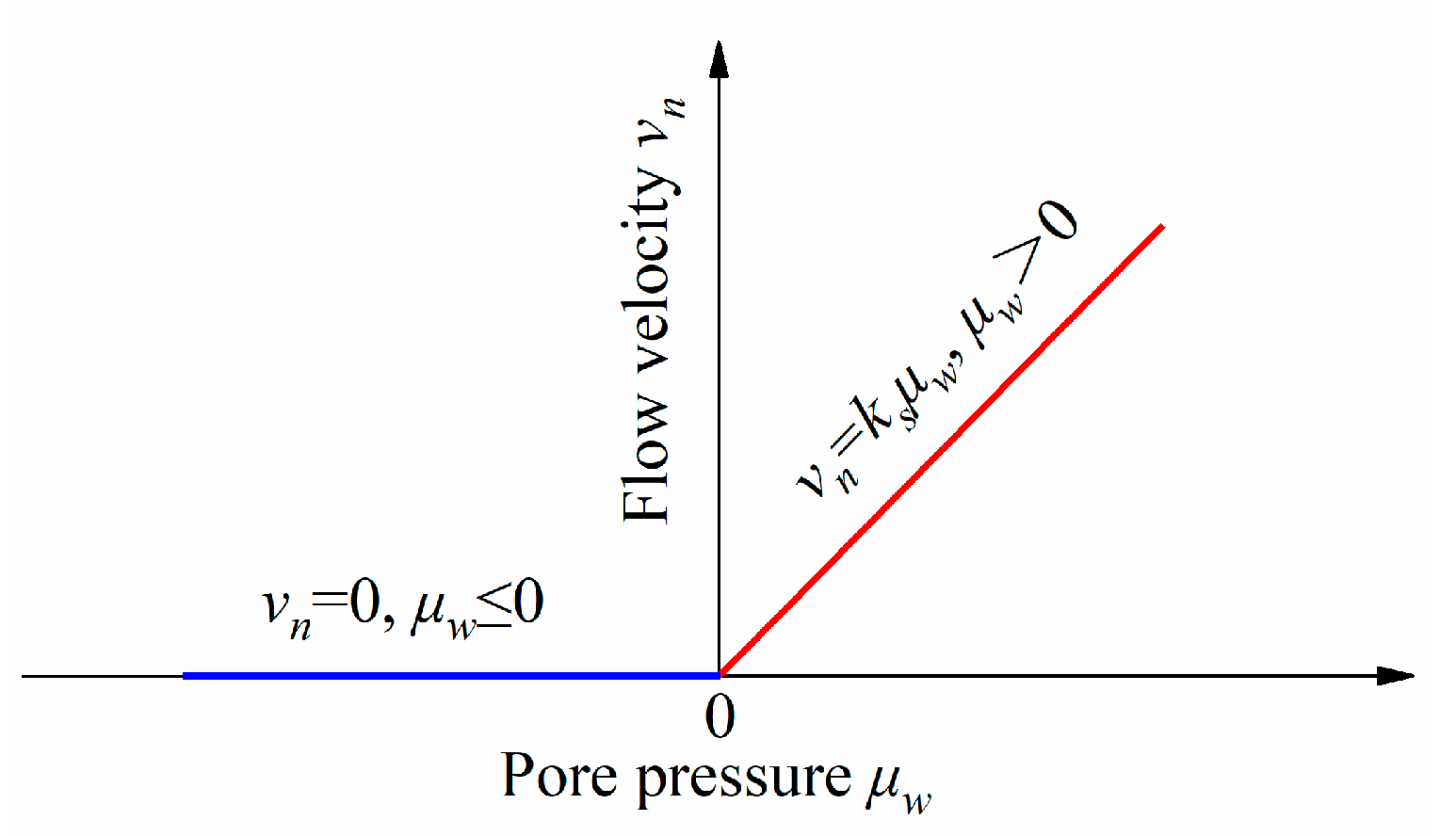

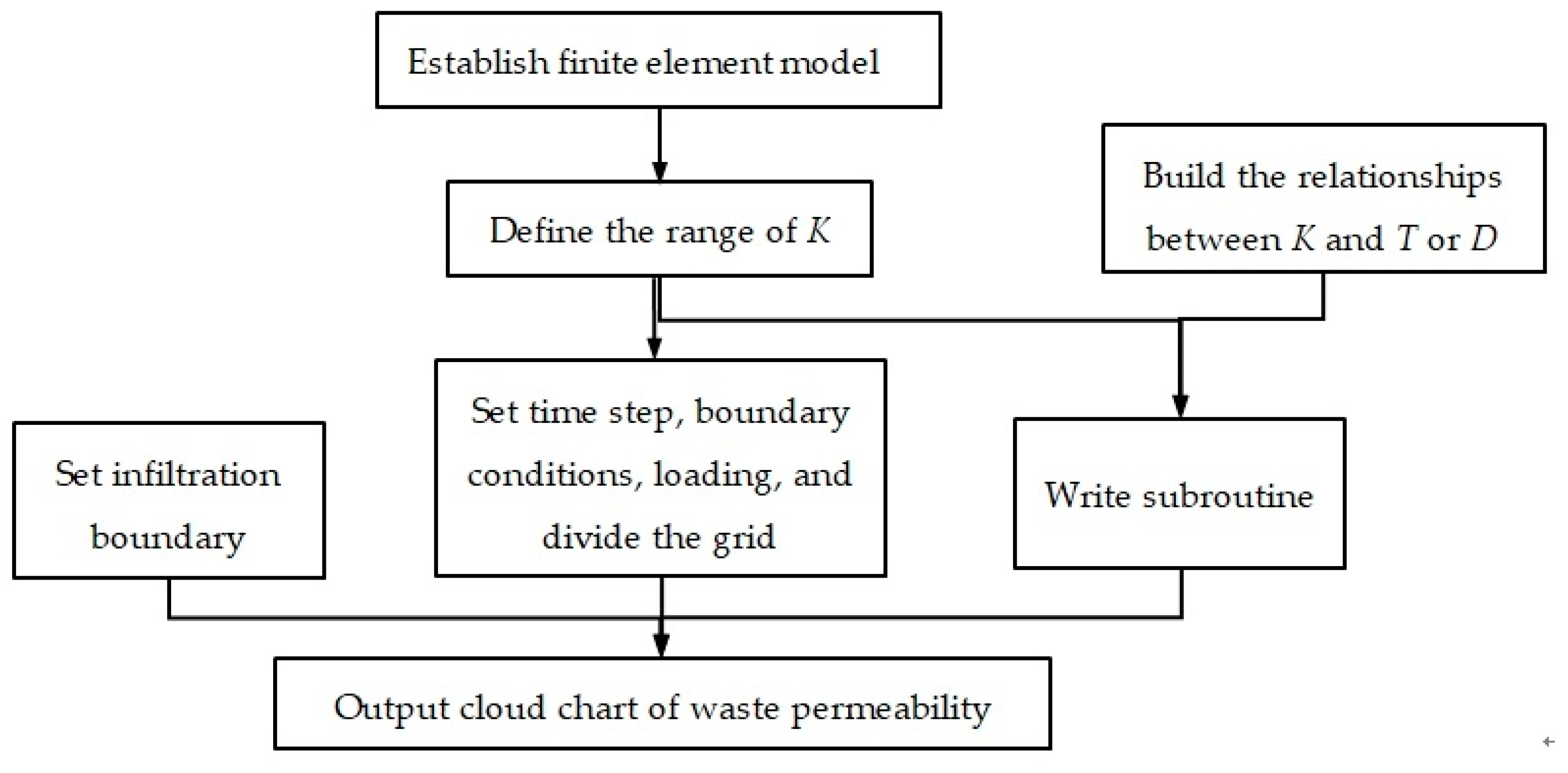
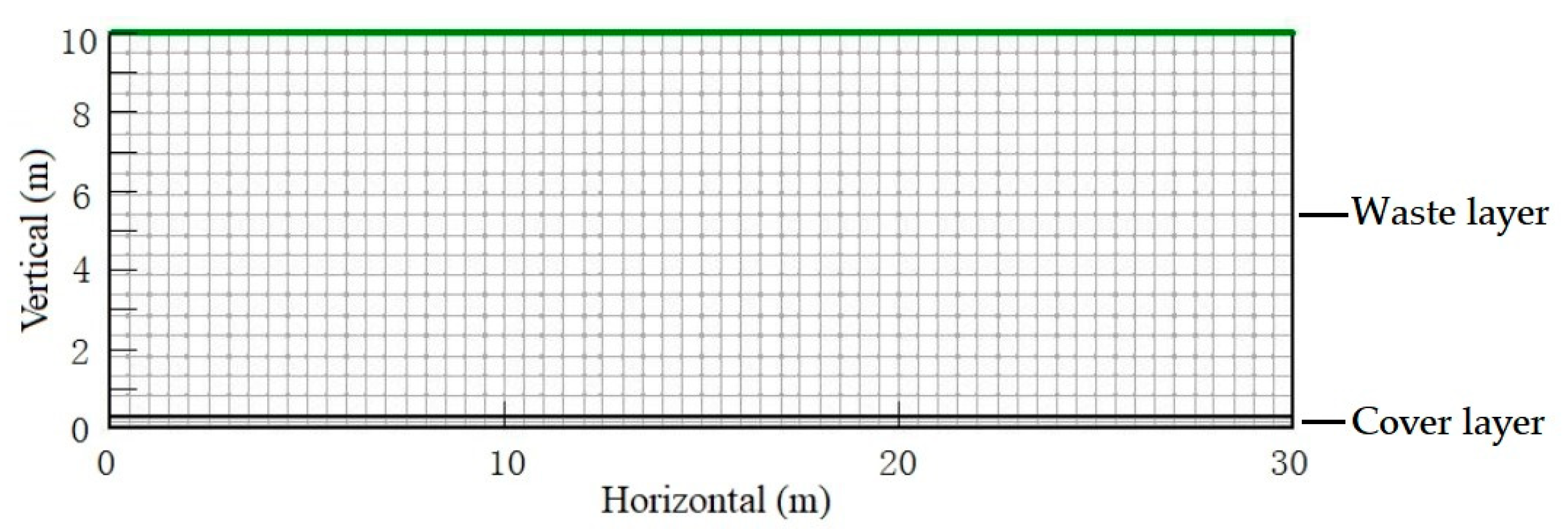
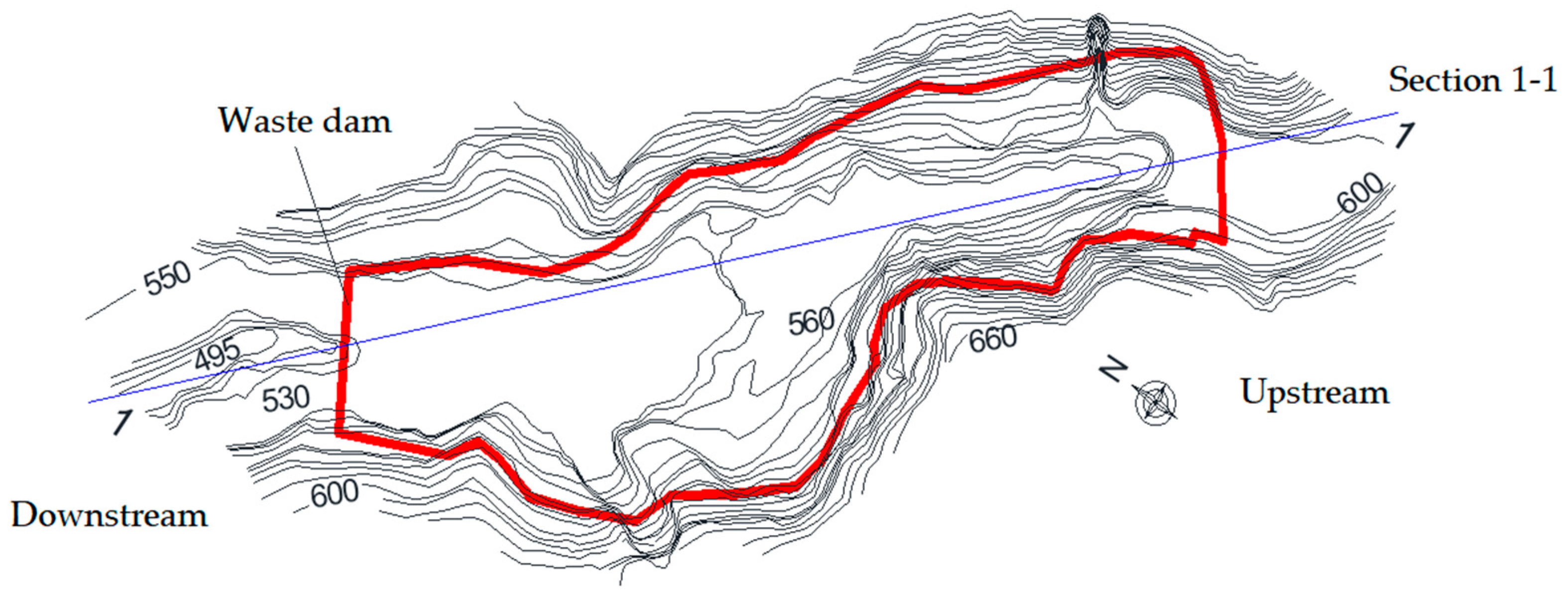


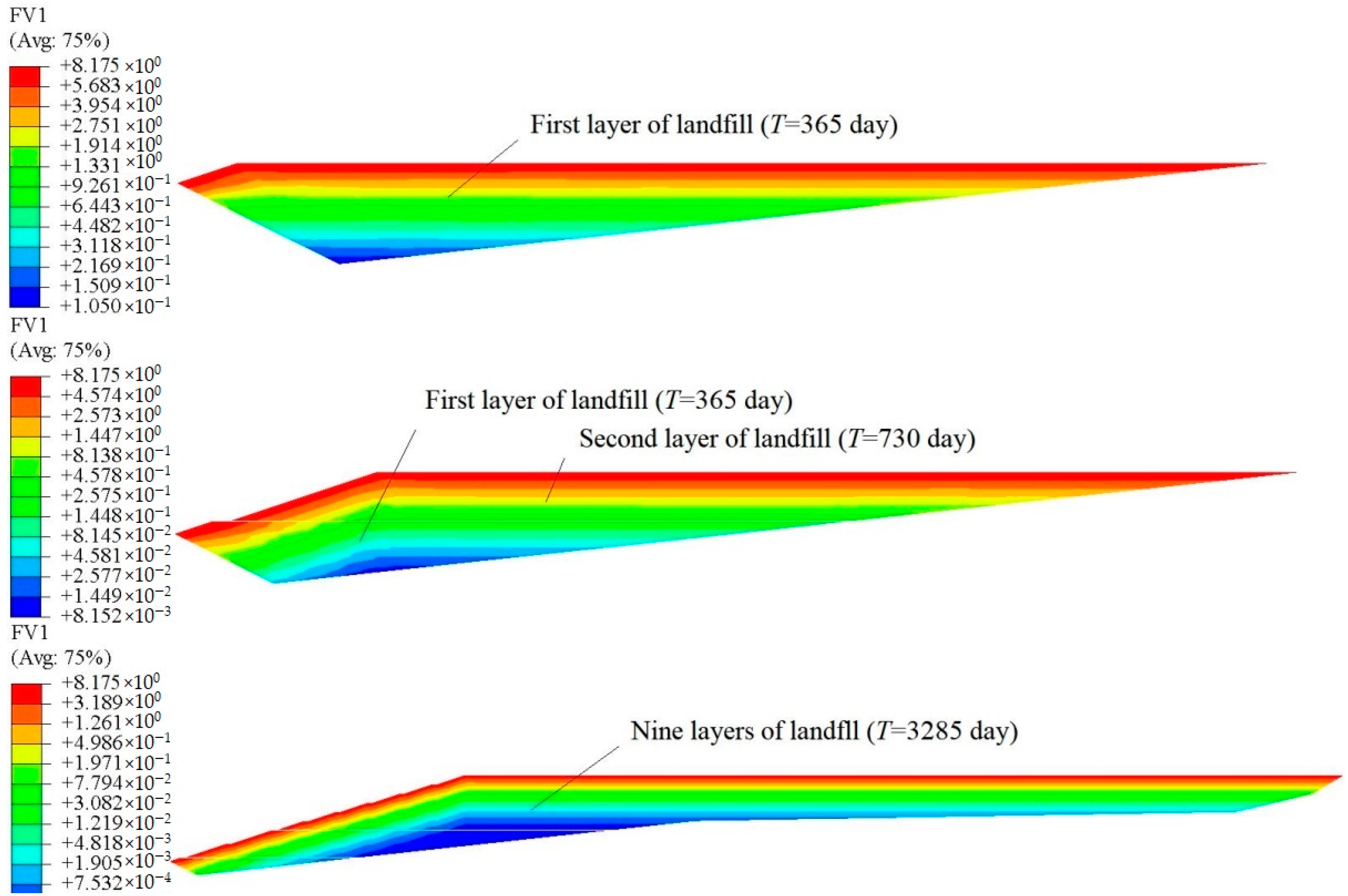
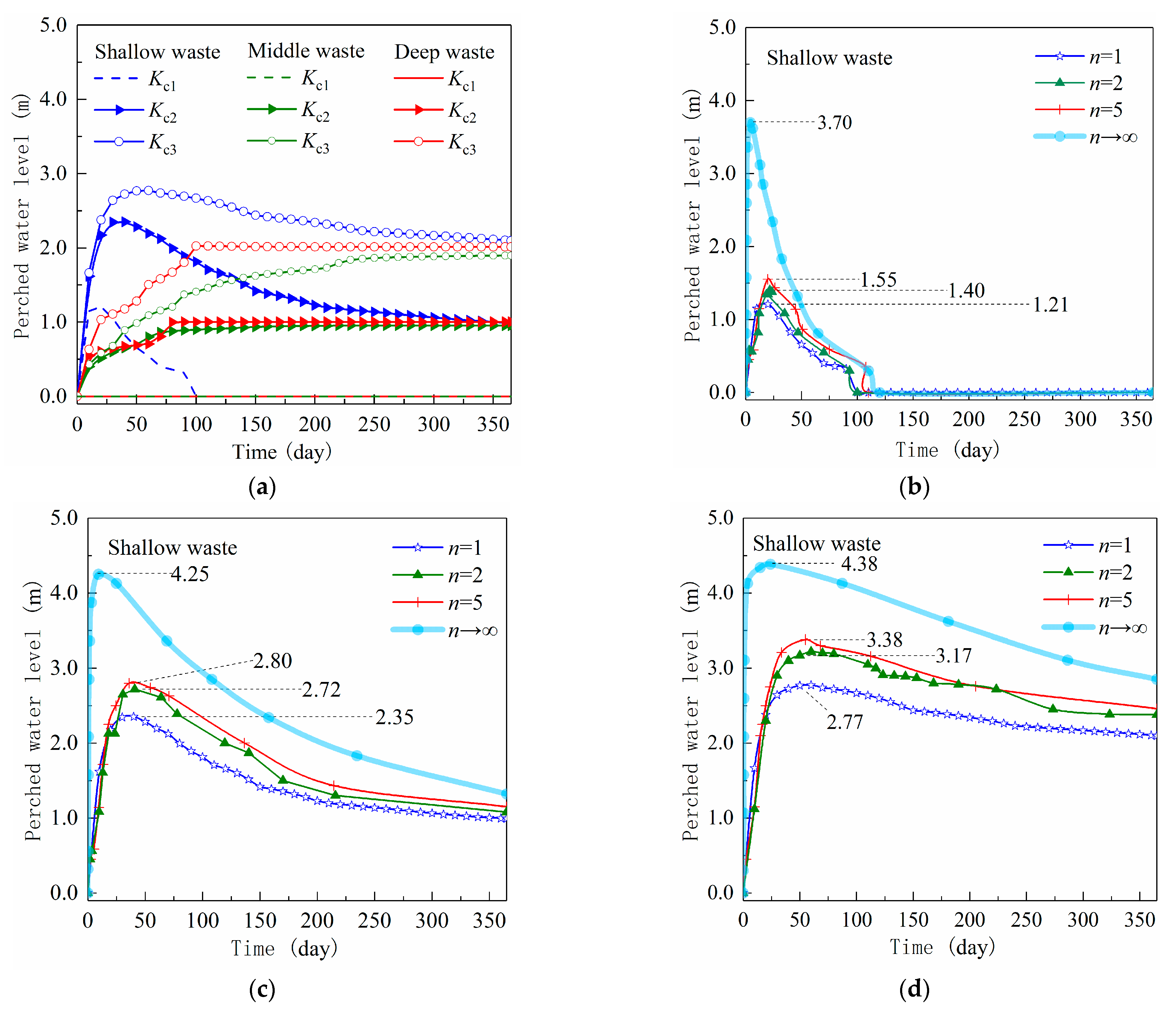



| Parameters | Details | |
|---|---|---|
| Rainfall | Month | 1, 2, 3, 4, 5, 6, 7, 8, 9, 10, 11, 12 |
| Daily rainfall (mm) | 0.02, 0.53, 0.28, 0.58, 2.63, 1.09, 2.52, 2.72, 9.48, 1.40, 2.17, 0.22 | |
| Saturated permeability (m/s) | MSW pile | ① [26] |
| K1, K2, K3, K4, K5, K6② | ||
| Waste dam | 1.0 × 10–9 | |
| Foundation | 1.0 × 10–9 | |
| The middle covering layer | 8.37 × 10–10 [51] | |
| Clogging Degree of Drainage Layer | Permeability Distribution of Waste Layer | Scheme |
|---|---|---|
| = 8.64 m/day | Homogeneity | 1 |
| Heterogeneity | 2 | |
| = 4.80 × 10−4 m/day | Homogeneity | 3 |
| Heterogeneity | 4 |
| Time (Day) | 365 | 730 | 1095 | 1460 | 1825 | ||
|---|---|---|---|---|---|---|---|
| Leachate level (m) | Scheme 1 | #1 + L1 | 12.90 | 13.70 | 15.17 | 15.30 | 15.80 |
| #2 + L2 | / | 8.13 | 6.30 | 5.70 | 5.70 | ||
| #2 + L3 | / | / | 5.92 | 4.70 | 3.70 | ||
| #3 + L4 | / | / | / | 4.61 | 3.10 | ||
| #4 + L5 | / | / | / | / | 5.18 | ||
| Scheme 2 | #1 + L1 | 12.70 | 12.90 | 13.60 | 13.80 | 14.25 | |
| #2 + L2 | / | 8.71 | 7.30 | 7.30 | 7.20 | ||
| #2 + L3 | / | / | 7.92 | 5.20 | 3.70 | ||
| #3 + L4 | / | / | / | 5.32 | 3.00 | ||
| #4 + L5 | / | / | / | / | 3.90 | ||
| Scheme 3 | #1 + L1 | 12.90 | 13.60 | 15.17 | 15.30 | 15.80 | |
| #2 + L2 | / | 6.80 | 6.30 | 6.00 | 5.90 | ||
| #2 + L3 | / | / | 6.60 | 5.00 | 3.70 | ||
| #3 + L4 | / | / | / | 5.20 | 4.90 | ||
| #4 + L5 | / | / | / | / | 5.50 | ||
| Scheme 4 | #1 + L1 | 12.80 | 13.70 | 13.40 | 14.80 | 15.80 | |
| #2 + L2 | / | 8.93 | 7.50 | 7.10 | 8.10 | ||
| #2 + L3 | / | / | 8.24 | 5.50 | 6.40 | ||
| #3 + L4 | / | / | / | 5.86 | 5.80 | ||
| #4 + L5 | / | / | / | / | 3.40 | ||
| Observation Well | #1 | #2 | #3 | #4 | #5 | |||||
|---|---|---|---|---|---|---|---|---|---|---|
| Waste Layer | 1, 2 | 2 | 3 | 4 | 5 | 6 | 7 | 8 | 9 | |
| The maximum perched water levels (m) | Scheme 1 | 17.60 | 8.94 | 6.82 | 4.90 | 5.18 | 5.52 | 6.23 | 6.67 | 6.24 |
| Scheme 2 | 17.60 | 8.71 | 7.92 | 5.32 | 7.06 | 7.32 | 7.44 | 7.92 | 6.96 | |
| Scheme 3 | 17.60 | 8.86 | 6.72 | 5.67 | 5.53 | 5.83 | 6.37 | 6.80 | 6.43 | |
| Scheme 4 | 17.60 | 8.94 | 8.24 | 5.84 | 7.33 | 7.56 | 7.48 | 7.93 | 7.13 | |
Disclaimer/Publisher’s Note: The statements, opinions and data contained in all publications are solely those of the individual author(s) and contributor(s) and not of MDPI and/or the editor(s). MDPI and/or the editor(s) disclaim responsibility for any injury to people or property resulting from any ideas, methods, instructions or products referred to in the content. |
© 2023 by the authors. Licensee MDPI, Basel, Switzerland. This article is an open access article distributed under the terms and conditions of the Creative Commons Attribution (CC BY) license (https://creativecommons.org/licenses/by/4.0/).
Share and Cite
Yang, R.; Ren, J.; Chang, X.; Yang, K. Seepage Model of Heterogeneous Municipal Solid Waste Landfill and Application under Process of Waste Accumulation. Water 2023, 15, 4115. https://doi.org/10.3390/w15234115
Yang R, Ren J, Chang X, Yang K. Seepage Model of Heterogeneous Municipal Solid Waste Landfill and Application under Process of Waste Accumulation. Water. 2023; 15(23):4115. https://doi.org/10.3390/w15234115
Chicago/Turabian StyleYang, Rong, Jianxi Ren, Xiaoke Chang, and Kun Yang. 2023. "Seepage Model of Heterogeneous Municipal Solid Waste Landfill and Application under Process of Waste Accumulation" Water 15, no. 23: 4115. https://doi.org/10.3390/w15234115
APA StyleYang, R., Ren, J., Chang, X., & Yang, K. (2023). Seepage Model of Heterogeneous Municipal Solid Waste Landfill and Application under Process of Waste Accumulation. Water, 15(23), 4115. https://doi.org/10.3390/w15234115





